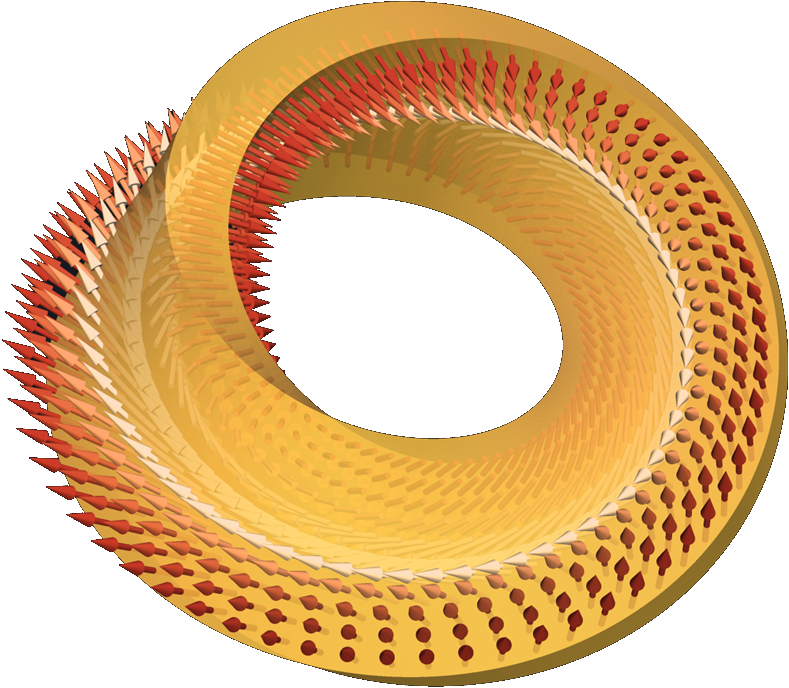Speaker
Description
Broken magnetic symmetry is a key aspect in condensed matter physics and in particular in magnetism. It results in the appearance of chiral effects, e.g. topological Hall effect [1] and non-collinear magnetic textures including chiral domain walls and skyrmions [2,3]. These chiral structures are in the heart of novel concepts for magnonics [4], antiferromagnetic spintronics [5], spin-orbitronics [6] and oxitronics [7].
The main origin of the chiral symmetry breaking and thus for the magnetochiral effects in magnetic materials is associated to an antisymmetric exchange interaction, the intrinsic Dzaloshinskii-Moriya interaction (DMI). At present, tailoring of DMI is done rather conventionally by optimizing materials, either doping a bulk single crystal or adjusting interface properties of thin films and multilayers. A viable alternative to the conventional material screening approach can be the exploration of the interplay between geometry and topology. This interplay is of fundamental interest throughout many disciplines in condensed matter physics, including thin layers of superconductors [8] and superfluids [9], nematic liquid crystals [10], cell membranes [11], semiconductors [12]. In the emergent field of curvilinear magnetism chiral effects are associated to the geometrically broken inversion symmetries [13]. Those appear in curvilinear architectures of even conventional materials. There are numerous exciting theoretical predictions of exchange- and magnetostatically-driven curvature effects, which do not rely on any specific modification of the intrinsic magnetic properties, but allow to create non-collinear magnetic textures in a controlled manner by tailoring local curvatures and shapes [14,15]. Until now the predicted chiral effects due to curvatures remained a neat theoretical abstraction.
Here, I review the very first experimental confirmation of the existence of the curvature-induced chiral interaction with exchange origin in a conventional soft ferromagnetic material. It is experimentally explored the theoretical predictions, that the magnetisation reversal of flat parabolic stripes shows a two step process. At the first switching event, a domain wall pinned by the curvature induced exchange-driven DMI is expelled leading to a magnetisation state homogeneous along the parabola's long axis. Measuring the depinning field enables to quantify the effective exchange-driven DMI interaction constant. The magnitude of the effect can be tuned by the parabola's curvature. It is found that the strength of the exchange-induced DMI interaction for the experimentally realised geometries is remarkably strong, namely $\approx 0.4~$mJ/m$^2$, compared the surface induced DMI. The presented study legitimates the predictive power of full-scale micromagnetic simulations to design the properties of ferromagnets through their geometry, thus stabilising chiral textures.
[1] N. Nagaosa, et al., Nature Nanotech. 8, 899 (2013)
[2] U. K. Rößler, et al., Nature 442, 797 (2006)
[3] A. Fert, et al., Nature Rev. Mat. 2, 17031 (2017)
[4] A. V. Chumak, et al., Nature Physics 11, 453 (2015)
[5] T. Jungwirth, et al., Nature Nanotech. 11, 231 (2016)
[6] I. M. Miron, et al., Nature 476, 189 (2011)
[7] V. Garcia, et al., Nature 460, 81 (2009)
[8] J. Tempere, et al., Phys. Rev. B 79, 134516 (2009)
[9] H. Kuratsuji, Phys. Rev. E 85, 031150 (2012)
[10] T. Lopez-Leon, et al., Nature Physics 7, 391 (2011)
[11] H. T. McMahon, et al., Nature 438, 590 (2005)
[12] C. Ortix, Phys. Rev. B 91, 245412 (2015)
[13] Y. Gaididei, et al., Phys. Rev. Lett. 112, 257203 (2014)
[14] J. A. Otálora, et al., Phys. Rev. Lett. 117, 227203 (2016)
[15] V. P. Kravchuk, et al., Phys. Rev. Lett. 120, 067201 (2018)

